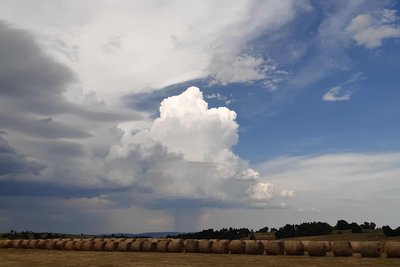Rain rather likes dry soils in a next-generation global climate model
Water stored in the soil provides one source of moisture to form clouds and ultimately precipitation. But the importance of this connection between water stored in the soil and precipitation has long been debated. In this study, the authors reassess this connection, for the first time using a climate model with a grid spacing allowing convective storms to be explicitly represented and by simulating the climate over the full globe. Past studies had either to use a limited integration domain, what prevents convective storms to interact with the large-scale circulation, or a statistical representation of convection due to their coarse grid spacing.
Conventional climate models show a strong positive correlation between daily soil moisture and daily precipitation. In contrast, the authors find only a weak correlation in their global storm-resolving simulation. Moreover, the correlation between daily soil moisture and next-day precipitation even becomes negative: drier soils are favorable for precipitation. Strikingly, whereas precipitation robustly increases with evaporation in conventional climate models, it exhibits a much more complex relationship in the global storm-resolving simulation. This suggests that the amount of water that can be evaporated from the soil is not the main mechanism that controls the precipitation amounts. The weaker correlation between soil moisture and precipitation is also in better agreement with observations.
The findings suggest that precipitation may be too sensitive to the state of the underlying land surface in conventional climate models. As a consequence, such models may overestimate the expected increase in the frequency and intensity of droughts and heatwaves under climate change. They may also be too sensitive to land surface changes, such as deforestation. The findings strongly speak for the use of global storm-resolving climate models to investigate the changing climate over land.
Original publication
Lee, J. and Hohenegger, C., 2024. Weaker land–atmosphere coupling in global storm-resolving simulation. Proceedings of the National Academy of Sciences, 121(12), p.e2314265121, https://doi.org/10.1073/pnas.2314265121
Contact
Dr. Junhong Lee
Max Planck Institute for Meteorology
junhong.lee@mpimet.mpg.de

